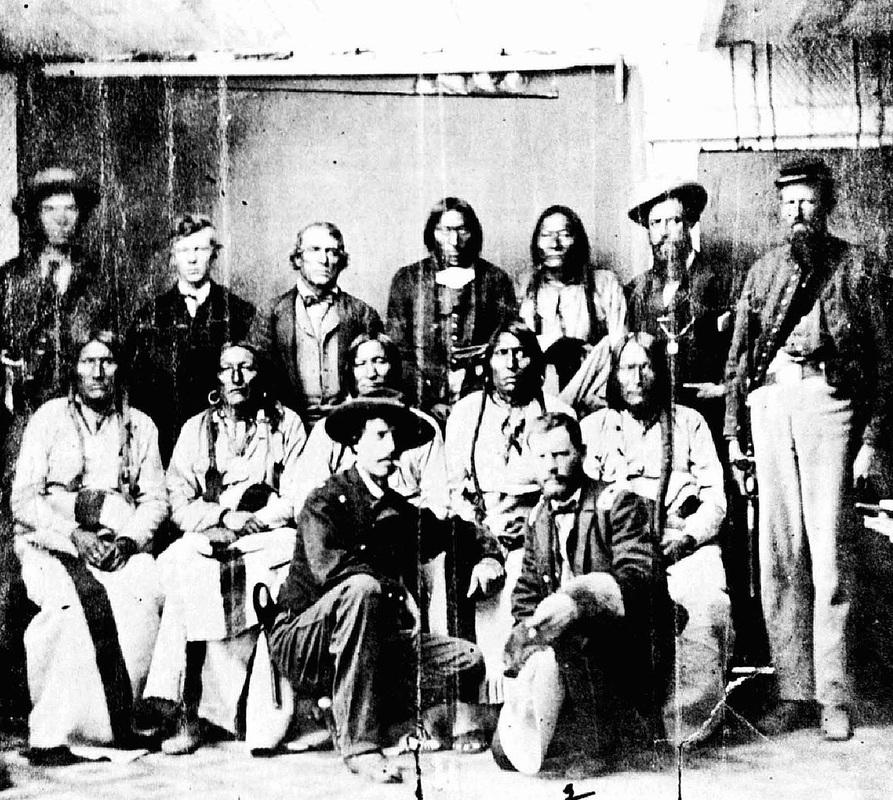|
If the Sand Creek Massacre is news to you, as it was to me, you need to know about this turning point in American History.
Warning: It's violent, gory and horrific, but one man had the courage to try to prevent the slaughter. And in that, I find hope. The attack in Colorado Territory came at dawn November 29, 1864. Indian villagers likely heard the pounding hooves before they saw the hundreds of blue-clad cavalrymen.
A Cheyenne chief raised the Stars and Stripes above his lodge. Others in the village of about 1000-people waved white flags. The troops responded with rifle and cannon fire. Witnesses say some two hundred people died, warriors trying to fight back with bows and arrows, others shot down as they tried to flee. Two-thirds of the dead and mutilated bodies left on the ground were women and children. Boasting of his victory Col. Chivington paraded the body parts of dead Cheyenne and Arapaho through the streets of Denver. 
A new award-winning book tells how Edward Wynkoop risked his life to meet with hostile Indians and negotiate peace in Colorado Territory.
Unfortunately, that peace never had a chance, due to prevailing attitudes of the times. "Damn any man who sympathizes with Indians! . . . . I have come to kill Indians, and believe it is right and honorable to use any means under God's heaven to kill Indians." -Colonel John Milton Chivington, U.S. Army. The bloodshed and betrayal at Sand Creek created intense mistrust among Plains Indians and hardened their resolve to resist white expansion. Warfare continued until another infamous massacre in 1890 at Wounded Knee extinguished the Indian's struggle. Repercussions from Sand Creek echo across the centuries impacting Native American culture and lives to the present day.
Black Kettle (seated center) and other Cheyenne chiefs conclude successful peace talks with Major Edward W. Wynkoop (kneeling with hat) at Fort Weld, Colorado, in September, 1864. Photo Courtesy National Archives.
Based on the promises made at this meeting, Black Kettle led his band back to the Sand Creek reservation, where they were massacred in late November. Read an eyewitness account in this article from the Smithsonian Magazine... Wynkoop biography  Nancy writes award-winning historical fiction, too. Nancy writes award-winning historical fiction, too.
Author Nancy Oswald was struck by Wynkoop's integrity and courage, and his humanness. "At times he was quite full of himself and acted rashly. But he also had the gift of gab which pulled his fat out of the fire more than once. He wasn’t afraid to stand up for what he believed in and was a man of action."
Nancy graciously agreed to give us a peek into her Wynkoop biography, a recent winner of the Spur Award from the Western Writers of America. Immediately before the massacre, Wynkoop was relieved from his command at Fort Lyon and told to report to his superior to explain the help he had given the Indians camped near Fort Lyon. After the massacre, and after convincing officials of wrongdoings, Wynkoop collected testimonies for the investigations of the massacre that would take place early in 1865. The atrocities committed at Sand Creek were both grisly and graphic. Despite the fact that Chivington (shown above) was found guilty of unnecessary brutality, he had mustered out of the military without punishment. Wynkoop became very unpopular. He was called an Indian lover and the “most hated man in Colorado.” He stood firm, remaining true to his beliefs. After retiring from the military, Wynkoop helped to negotiate treaties with the Plains Indians and fought for them when annuities were not delivered on time. Often Wynkoop secured and delivered the rations himself, and he acted as a go-between when terms of the treaties were breached. Wynkoop became known as one of the few white men the Plains Indians trusted.
In 1864, Edward WynKoop's work for peace came to nothing. But his courage to sit down and talk with the enemy gives me hope. If a guy could do it then, surely we can find a way toward creating more peace in our world today. Any ideas? Can we individually make a difference?
Comments are closed.
|
I'm fascinated to discover little-known history, stories of people and events that provide a new perspective on why and how things happened, new voices that haven't been heard, insight into how the past brought us here today, and how it might guide us to a better future.
I also post here about my books and feature other authors and their books on compelling and important historical topics. Occasionally, I share what makes me happy, pictures of my garden, recipes I've made, events I've attended, people I've met. I'm always happy to hear from readers in the blog comments, by email or social media. Archives
September 2023
Categories
All
|


